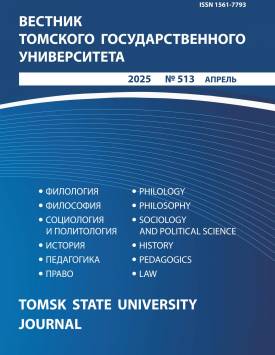Bioimpedance analysis of body composition in female athletes in gymnastic sports
The problem of studying the component composition of the female athlete's body in gymnastic sports unites scientists from many countries of the world, but all researchers agree that the additional burdening of gymnasts with "excess" weight limits their athletic performance. Nevertheless, reducing fat mass below reference values is not recommended at any age and in any sports discipline. The aim of the study is to identify the morphofunctional status and characteristics of the body composition component of female athletes aged 12-14 and 15-18 from Tyumen Oblast teams in cheerleading, artistic gymnastics, and aerobics. The study involved 23 female athletes aged 12 to 18 years, of which 17% were girls from the artistic gymnastics team, 35% from the cheerleading one, and 48% from the aerobic gymnastics one. The study was conducted at the University of Tyumen using InBody 370, a multi-frequency bioimpedance analysis equipment. According to the results of anthropometric diagnostics, it was found that cheerleaders and aerobic athletes aged 12-14 correspond to the average height indicators (151 and 153 cm), and gymnasts aged 12-14 correspond to the level below the norm (145 cm). By the age of 15-18, the differences in body length indicators for all female athletes are smoothed out (from 163.7 to 165.5 cm). In terms of body weight indicators, on the contrary, there is a significant difference in indicators between the 15-18 age group (from 54.2 kg in gymnastics to 65.4 kg in cheerleading) and the 12-14 group (from 37 kg to 41 kg). The results of bioimpedance analysis of body composition showed that in absolute muscle mass indicators, female athletes aged 15-18 had similar data (from 26.5 to 26.9 kg), and at the age of 12-14, gymnasts exceeded aerobic athletes and cheerleaders by 2 kilograms of muscle mass. It was found that muscle hypertrophy of all body segments is characteristic for 100% of gymnasts, 54.5% of aerobic athletes and 12% of cheerleaders. At the age of 12-14, the difference in fat mass of female athletes was 3.1 kg (min for aerobic athletes - 3.3 kg, max for cheerleaders - 6.4 kg), while at the age of 15-=18 it was 9.9 kg (min for gymnasts - 7.0 kg, max for cheerleaders - 16.9 kg; p<0.05). More than half of the girls (62%) had a deficit in fat mass (100% in gymnastics, 63% in aerobic gymnastics, 50% in cheerleaders), and a surplus was found in one athlete in cheerleaders. As a result, the obtained average group characteristics of anthropometry and component composition of female athletes in the regional teams will serve as the basis for the development of the information and analytical digital service to support long-term training in gymnastics. The author declares no conflicts of interests.
Keywords
body composition, bioimpedance analysis, adolescent girls, aerobic gymnastics, artistic gymnastics, cheerleadingAuthors
| Name | Organization | |
| Chayun Danil V. | University of Tyumen | d.v.chayun@utmn.ru |
References

Bioimpedance analysis of body composition in female athletes in gymnastic sports | Vestnik Tomskogo gosudarstvennogo universiteta – Tomsk State University Journal. 2025. № 513. DOI: 10.17223/15617793/513/24
